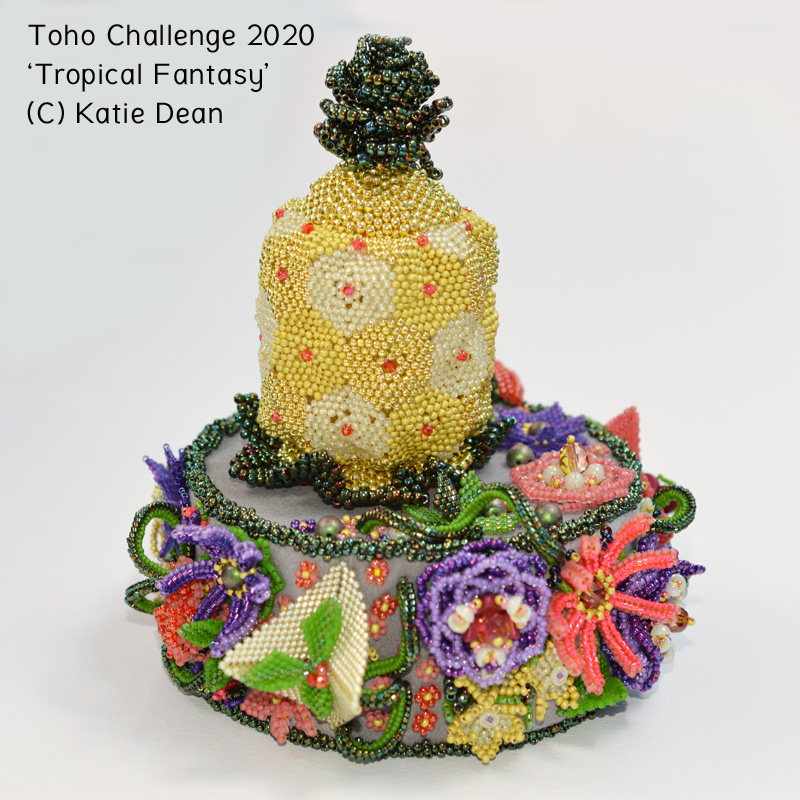One-G Beading Thread from TOHO
I’m gradually adding to my personal explorations of beading thread. I could just write about all the threads on the market, but I like to actually try them first. So, that way, I can share my real experience, not just a theoretical guide. Now today, let’s take a look at One-G beading thread.
What is One-G beading thread?
I gave you a little clue in the blog title. This is a beading thread that has been developed by a bead manufacturer: TOHO. It is a nylon beading thread. So, for those of you who are new to beading, that means it feels a lot like a cotton or sewing thread. Yet, the nylon is super-strong.
Now, a lot of nylon threads have a nasty tendency to twist and knot very easily. Obviously, this is extremely frustrating if you’re trying to bead!
So, I had read that One-G has been treated to prevent this from happening. I’ve now had the opportunity to use the thread myself, and I can report that it has performed well.
I actually used this on a very big beading project, working with different types of beads. You can see the project in the photo below – it was my contribution to the TOHO Challenge for 2020.

So, as you can imagine, this really put the thread through its paces! And I didn’t struggle with knots, fraying and tangling. So, I would certainly recommend One-G beading thread.
Colours and sizes
Most beaders are divided as to whether nylon-based or monofilament-based beading threads are ‘better’. The real truth is, neither one is ‘better’. Some threads have definite advantages for certain types of project. And some beaders will find some threads more enjoyable to use.
So, my advice is always to try out different options and discover what works well for you.
Having said that, one of the great advantages of the nylon-based threads is their colour. You see, your thread will show through your beads to some degree. So, its colour can affect how your beads appear.
Also, in some techniques, there is more visible thread between the beads. So, that can mean you want to match your thread colour to your beads. This brand of thread is available in 12 colours currently (10 ‘colours’, plus black and white). The colours are beautiful, and don’t come off when working.
You can also choose different spool sizes. So, the smallest spools contain 50 yards of thread. The largest contains 250 yards. That will go a long way!
The standard thickness has been designed to work with the TOHO beads, but of course it works with other brands as well.

Choosing your thread
Now, I’ve written a few blogs on beading thread. Aside from looking at individual threads, I’ve also spoken about choosing your thread. I’ve answered some questions about why I most often use Fireline, rather than any other thread. And, I’ve talked about how you can choose the best thread for your project if a designer hasn’t made a recommendation. So, you can check out all those posts in this section.
I hope this little article has given you some idea of what this kind of thread is. You can certainly use it with any seed beads, and for both bead-weaving, loomwork, and bead embroidery projects. So, it’s a versatile thread, great to use, and certainly another option for you to try.
Want to learn more about beading? Click here to join my mailing list and receive a welcome gift, then get a monthly newsletter.












Katie, I have used Nymo Nylon thread for a long time (I have been beading for 25 years…when the choices for thread were Nymo or Silamide!) . I have always found that it tends to split (the needle going through the thread on a second pass) or fray. Does G-1 split the same way? or fray?
Hi Karen, I remember the good old days when Nymo and silamide were the only options! Like you, I used Nymo for many years, until better things came along. So, to answer your question, everyone has different experiences with thread, so the best way to find what works for you is to try some different options. My personal experience with One-G is that it doesn’t split or fray like Nymo, so it is something I am happy using. Definitely give it a try and see how you get on with it.
Thank you, Katie.